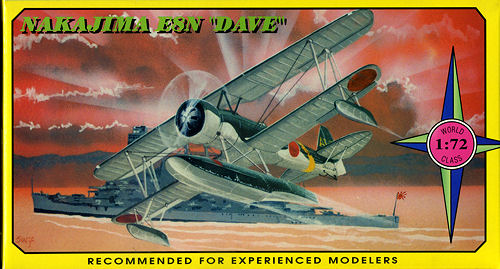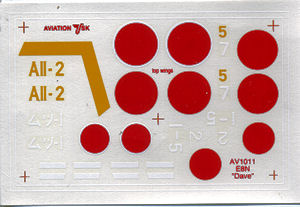
| KIT #: | AV-1011 |
| PRICE: | $17.95 when new a while back. |
| DECALS: | Four options |
| REVIEWER: | Scott Van Aken |
| NOTES: | Short run kit. |

| HISTORY |
The E8N was developed as a replacement for the same company's E4N and was essentially an evolutionary development of the earlier type, with revised wings of lesser area and taller tail surfaces. Seven prototypes were constructed, under the company designation MS, first flying in March 1934. These were duly engaged in comparative trials against competitors from Aichi and Kawanishi.
The MS was ordered into production, designated Navy Type 95 Reconnaissance Seaplane Model 1 in October 1935. A total of 755 E8Ns were built by Nakajima and Kawanishi, production continuing until 1940. It was subsequently shipped aboard all the capital ships then in service, 16 cruisers and five seaplane tenders.
It was used successfully in the Second Sino-Japanese War not only for reconnaissance, but also for dive-bombing and artillery spotting.
One E8N was purchased in early 1941 by the German Naval Attache to Japan, Vice-Admiral Wenneker, and dispatched on board KM MUNSTERLAND to rendezvous with the German auxiliary cruiser Orion at Maug Island in the Marianas. The meeting occurred on 1 FEB 1941, and Orion thus became the only German naval vessel of the Second World War to employ a Japanese float plane.
Some aircraft remained in service with the fleet at the outbreak of the Pacific War but they were soon replaced by more modern aircraft such as the Aichi E13A and the Mitsubishi F1M, being reassigned to second-line duties.
| THE KIT |
 Instructions
are a single sheet of paper that has been folded. There are two exploded views.
One concentrates on interior installation and the other takes care of the rest
of the kit. Plastic has fine external detailing that will disappear under any
sanding. The fabric representation is quite subdued, which will please those who
are not fond of 'hills and valleys'. The interior is simply a flat floor with
two seats and a control stick for the pilot. An instrument panel with no detail
is included. There is no rear defensive gun and any interior bulkheads will need
to be made by the modeler. I should also point out that no windscreens are
given, those needing to be made as well. No template is provided.
Instructions
are a single sheet of paper that has been folded. There are two exploded views.
One concentrates on interior installation and the other takes care of the rest
of the kit. Plastic has fine external detailing that will disappear under any
sanding. The fabric representation is quite subdued, which will please those who
are not fond of 'hills and valleys'. The interior is simply a flat floor with
two seats and a control stick for the pilot. An instrument panel with no detail
is included. There is no rear defensive gun and any interior bulkheads will need
to be made by the modeler. I should also point out that no windscreens are
given, those needing to be made as well. No template is provided.
You get a fairly nice engine with a cowling that is split into upper and lower sections. An exhaust collector fits to the back of the engine. There are a lot of struts with the ones that attach to the float being separate. The outer wing float half has struts molded to it and the inner ones will need to be attached separately. Both N struts are a single piece with the interplane struts being in sections. Control rods between the upper and lower wing are included.
Rigging information will need to come from the box art for the
most part. The
 color
and markings page shows any side rigging so by combining the two, the builder
should be able to do a credible job. Markings are provided for four aircraft and
are basically differences in fin/rudder codes. Float dolly markings are provided
as decals.
color
and markings page shows any side rigging so by combining the two, the builder
should be able to do a credible job. Markings are provided for four aircraft and
are basically differences in fin/rudder codes. Float dolly markings are provided
as decals.
The first markings option is overall silver with a red tail with Kanji writing in white. It was aboard the Mutsu in 1937. The other three are camouflages in brown and green over light grey. First is one from the tender Kamui in 1937 with the numbers 5 and 7 on the rudder. Next is the box art plane with a fuselage stripe. It is from the Mutsu as well, but this time in 1941. The finally one is coded 2 I-5 and was from the carrier Zuiho when it was sunk in May of 1942. The decals look OK, but I would recoat them just to be sure as this kit is nearly 20 years old.
| CONCLUSIONS |
I am not sure if Fujimi or anyone else has reproduced this aircraft for the injected plastic crowd or not. If not, then you will need to look around for this one as Aviation Usk has been out of business for quite a while. As an early short run kit, you will need to use quite a few of those modeling skills to complete this one. The box touts the 'upcoming 1995' releases so this one has to be from 1994 or possibly 1993. If you can find one and handle the work it will take to build, then go for it.
| REFERENCES |
http://en.wikipedia.org/wiki/Nakajima_E8N
January 2013
Thanks to my kit stash for this one.
If you would like your product reviewed fairly and fairly quickly, please contact the editor or see other details in the Note to Contributors.